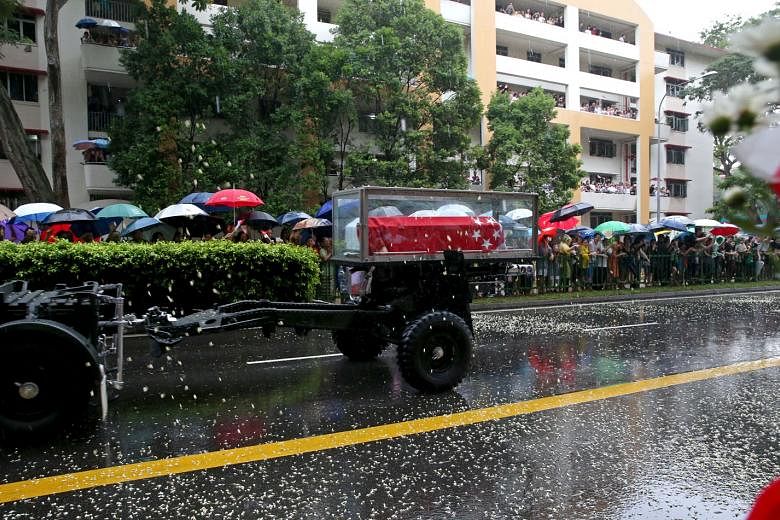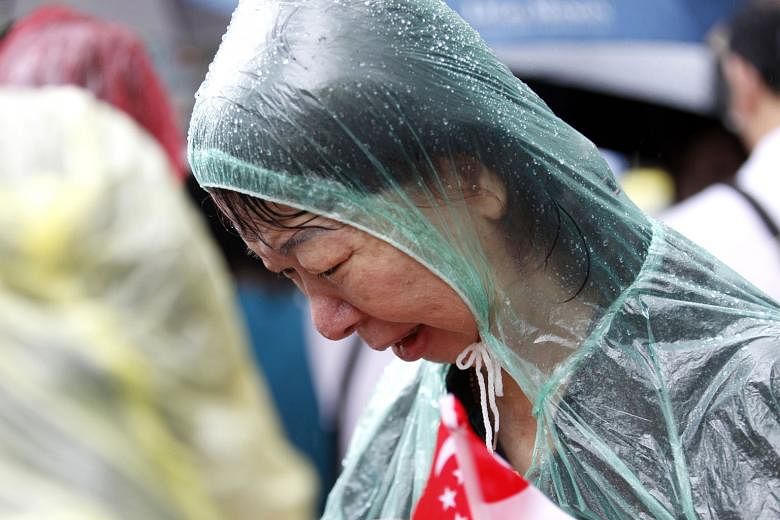When news broke on March 23 that the nation's first prime minister Lee Kuan Yew had died in the wee hours of that morning, the dam that held back Singaporeans' hopes, wishes and worst fears broke.
People wept openly, waited for hours in long queues to pay their last respects and stood in the torrential rain along the funeral route to bid their final farewell to the man who played a pivotal role in bringing Singapore from Third World to First World in less than 50 years.
The swell of sorrow had been building up, with the Singapore General Hospital and Tanjong Pagar Community Club becoming a repository of flowers, cards and posters that expressed people's hopes and wishes for Mr Lee to get well.
But these places, as well as the Istana gates, were swiftly transformed into sombre mourning grounds as the sun rose on that Monday morning.
As Singaporeans grieved during the seven days of national mourning, a stirring change was felt by many. Mr Lee, in death as in life, gave the increasingly fractious nation a treasured gift: a state of closeness from a shared sense of loss.
The nation grew more united.
At the same time, the younger generation became more aware of the achievements of the pioneer generation of political leaders.
Mr Lee, 91, had been in poor health for over a year and on Feb 5 was admitted to Singapore General Hospital. The Prime Minister's Office (PMO) announced it on Feb 21 and subsequent statements sparked a feeling of dread among many.
On March 17, the PMO told Singaporeans his condition had taken a turn for the worse .
Social media brought out the worst in some who found macabre delight in posting hoax reports of his death. Several international media agencies were taken in, particularly by a fake post on March 18.
Mr Lee breathed his last at 3.18am on March 23.
As Singaporeans woke up to the news, many swarmed the Istana gates - Mr Lee's office was at the Istana - to leave flowers, lit candles and condolence messages.
Beyond the gates, at Sri Temasek, the official residence of the Prime Minister, Mr Lee's family held a private family wake for two days.
The rest of Singapore sought solace at community clubs, including the Tanjong Pagar Community Club.
As the crowds grew, another 17 tribute centres were opened by the People's Association, with 10 staying open round the clock.
The rich and poor, able-bodied and wheelchair-bound, Singaporeans and foreigners: all came to pay their respects.
Older folk recounted the many events they linked to Mr Lee, especially the day he cried on television in 1965 when announcing that Singapore had been kicked out of Malaysia, and how he spearheaded a campaign to clean up Singapore's rivers. Teenagers who had only read about the man in history books felt, for the first time, the weight of his legacy.
It sparked discussions about what Mr Lee and other pioneer leaders, even those who bitterly opposed him, had achieved for the country. These continue today, even as the first phase of public consultation for a Founders' Memorial concluded last week.
Most Singaporeans feel a deep sense of gratitude for Mr Lee's pragmatism and fervour in having a clean government as well as a meritocratic, multiracial and multi-religious society.
Still, the long queues at Parliament House, where Mr Lee's body was lying in state, surprised many. More than 450,000 people paid their respects over four days.
At its peak, tens of thousands endured 10 hours of waiting in line under a blazing sun for a brief moment and sight of Mr Lee's casket.
The overwhelming response prompted government officials to extend visiting times not once, but twice within the first day of public mourning. Instead of getting to pay their respects for 10 hours a day, people could do so round the clock.
One of the many tributes was from the MPs, at a special Parliament sitting convened on Thursday, March 26. In a stirring address, Defence Minister and then-Leader of the House Ng Eng Hen talked about how Mr Lee had led Singapore in chaotic times and through tough measures, like extending work hours, that paid off only later.
Reflecting the respect Mr Lee commanded internationally, flags were flown at half-mast in New Zealand and India on the day of his funeral . Former US president Bill Clinton, Indian Prime Minister Narendra Modi, Indonesian President Joko Widodo and Malaysian Prime Minister Najib Razak were among the world's leaders who flew in to attend the proceedings.
But at the final count, it was the people of Singapore, who mattered most to Mr Lee, that gave him the most poignant farewell on Sunday, March 29. In pouring rain, they came out to line the 15.4km route his cortege travelled for an hour, from Parliament House to the state funeral service in Kent Ridge.
While some wore ponchos and carried umbrellas, many went without. One man told reporters that Mr Lee went through much more than mere storms to bring Singapore to where it was today.
At the funeral, telecast live, President Tony Tan Keng Yam and Emeritus Senior Minister Goh Chok Tong were among 10 people who delivered eulogies. Later, a private funeral was held for the Lee family to say goodbye to their patriarch who loved his family in his own stoic way.
As Prime Minister Lee Hsien Loong said: "The light that has guided us all these years has been extinguished." But in death, Mr Lee Kuan Yew has fired up the Singapore spirit, giving people renewed purpose to honour him by moving forward - and upwards.



